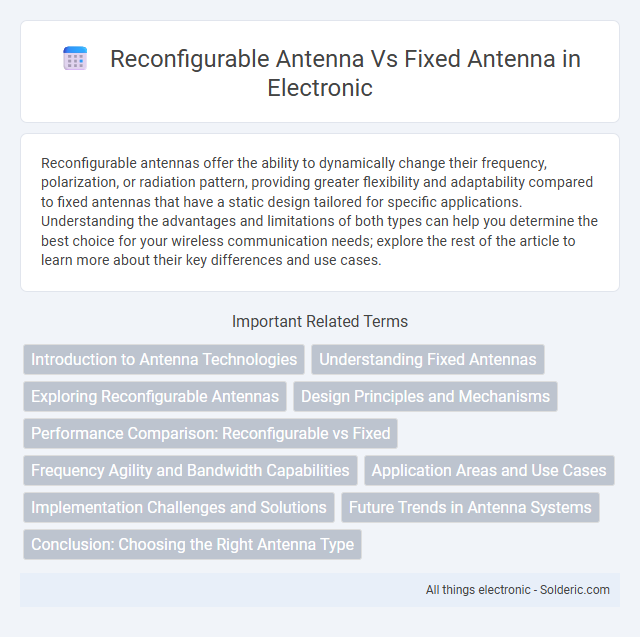Reconfigurable antennas offer the ability to dynamically change their frequency, polarization, or radiation pattern, providing greater flexibility and adaptability compared to fixed antennas that have a static design tailored for specific applications. Understanding the advantages and limitations of both types can help you determine the best choice for your wireless communication needs; explore the rest of the article to learn more about their key differences and use cases.
Comparison Table
| Feature | Reconfigurable Antenna | Fixed Antenna |
|---|---|---|
| Definition | Ability to dynamically change frequency, polarization, or radiation pattern. | Static design with fixed frequency, polarization, and radiation pattern. |
| Frequency Range | Wide and tunable across multiple bands. | Limited to a specific frequency band. |
| Flexibility | High; adapts to varying operational requirements. | Low; fixed operational parameters. |
| Complexity | Higher due to tuning components and control circuits. | Lower, simpler design and manufacturing. |
| Cost | Generally higher initial cost. | Lower cost and easier production. |
| Applications | Software-defined radios, cognitive radio, multi-band devices. | Conventional communication systems, fixed frequency applications. |
| Performance | Optimized dynamically for varying conditions. | Consistent but limited to fixed scenarios. |
Introduction to Antenna Technologies
Reconfigurable antennas adapt their frequency, polarization, or radiation pattern dynamically, enhancing communication system flexibility and efficiency. Fixed antennas have predetermined characteristics optimized for specific frequencies or applications, providing stable and reliable performance. Advances in materials and tunable components drive the growing use of reconfigurable antennas in modern wireless networks and cognitive radio systems.
Understanding Fixed Antennas
Fixed antennas are designed with a set structure and parameters that remain constant, providing reliable performance for specific frequency bands and applications. Their predictable radiation patterns and stable gain make them ideal for environments where signal requirements do not change. Understanding fixed antennas helps you select the right type for consistent communication needs without the complexity of tuning or adaptation.
Exploring Reconfigurable Antennas
Reconfigurable antennas offer dynamic adaptability by altering their frequency, radiation pattern, or polarization in real-time, unlike fixed antennas that operate at predetermined parameters. This flexibility enhances performance in wireless communication systems, enabling better spectrum utilization, interference mitigation, and multi-band functionality. Advanced materials and switchable components such as PIN diodes and MEMS facilitate these tunable capabilities, making reconfigurable antennas crucial for next-generation 5G, IoT, and cognitive radio networks.
Design Principles and Mechanisms
Reconfigurable antennas utilize tunable components such as varactors, MEMS switches, or PIN diodes to dynamically alter their frequency, polarization, or radiation pattern, enabling adaptability to varying communication environments. Fixed antennas rely on static geometries and materials designed for specific operational parameters, offering simplicity and consistent performance but limited flexibility. Understanding these design principles helps you select the optimal antenna solution for applications needing real-time adaptability versus stable, single-purpose use.
Performance Comparison: Reconfigurable vs Fixed
Reconfigurable antennas offer superior adaptability with dynamic frequency tuning, polarization control, and radiation pattern adjustment, enhancing signal quality and reducing interference compared to fixed antennas. Fixed antennas provide consistent, stable performance in a single frequency band but lack flexibility for multi-band or evolving communication standards. Your choice depends on whether optimal performance across varied conditions or simple, reliable operation is the priority.
Frequency Agility and Bandwidth Capabilities
Reconfigurable antennas exhibit superior frequency agility by dynamically tuning their operating frequencies to adapt to varying signal environments, enabling multi-band or wideband performance within a single device. Fixed antennas, in contrast, are limited to predefined frequency bands with static bandwidth capabilities, restricting their flexibility in communication systems. This adaptability of reconfigurable antennas enhances spectral efficiency and supports diverse wireless applications requiring rapid frequency shifts.
Application Areas and Use Cases
Reconfigurable antennas are widely used in advanced communication systems, including cognitive radios, satellite communications, and IoT devices, where adaptability to changing frequency bands and environments enhances performance. Fixed antennas dominate traditional applications such as broadcast television, radio, and cellular base stations, providing consistent and reliable signal transmission for specific frequency bands. Your choice between reconfigurable and fixed antennas depends on whether your application demands flexibility for multi-band or multi-function capabilities or stability for dedicated, high-efficiency signal transmission.
Implementation Challenges and Solutions
Reconfigurable antennas face implementation challenges such as increased design complexity, integration of tunable components like MEMS or varactors, and maintaining performance across varying frequency bands. Solutions involve advanced simulation tools for precise modeling, the use of low-loss tunable materials, and adaptive control algorithms to optimize antenna behavior dynamically. Your system benefits from these innovations by achieving versatile performance while minimizing the trade-offs commonly seen in fixed antenna designs.
Future Trends in Antenna Systems
Reconfigurable antennas offer significant advantages over fixed antennas in future communication systems by providing adaptive frequency, radiation pattern, and polarization changes, which support dynamic and multi-standard wireless environments. These antennas are essential for next-generation 5G and beyond networks, enabling efficient spectrum usage and enhancing connectivity in IoT, smart cities, and advanced defense applications. Your communication systems benefit from the flexibility and enhanced performance of reconfigurable antennas, driving innovation in adaptive wireless technologies and improving overall network reliability.
Conclusion: Choosing the Right Antenna Type
Selecting between reconfigurable and fixed antennas depends on application-specific requirements such as adaptability, cost, and complexity. Reconfigurable antennas offer dynamic frequency, polarization, and radiation pattern adjustments, ideal for multi-band and evolving communication systems. Fixed antennas provide lower cost and simplicity, making them suitable for stable, single-purpose applications with fixed operating conditions.
reconfigurable antenna vs fixed antenna Infographic

 solderic.com
solderic.com